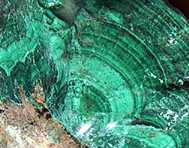
Gems like malachite, which are stunningly beautiful, yet common and inexpensive, always bring to my mind the "No respect" phrase made familiar by Rodney Dangerfield. Pretend for a moment that there were just a handful of specimens to be had, think how we would sing its praises, and long to own one. Despite ready availability, though, malachite has a great deal to recommend it to the gem lover, or to anyone simply interested in Nature's wonders.
Our forebears valued the dramatic colors of this mineral not only for use as an ornamental material and a gemstone, but also in ground form as a cosmetic (eye shadow). Unfortunately, although the results may have been beautiful, they were also hazardous to health: the copper content of the dust released from grinding this stone makes it toxic to breathe. (Today those workers involved in the mining and fashioning of malachite are advised to wear protective respiratory gear, and to keep dust to a minimum by keeping the rough wet.)
There is evidence that malachite was mined in Egypt as early as 4000 BCE. Early on it was ground and used as a pigment for paints. Not until the industrial revolution were synthetic pigments created that could rival the green hues achieved this way. Those who restore and conserve old paintings still use the old malachite based formula for authenticity.
There is disagreement in the mineralogical literature as to the derivation of the name. Most writers agree that the word comes from the Greek, but there is a split between those favoring malakos meaning soft, and those who propose malakhe meaning the green herb, mallow, a reference to the color.
Invariably associated with deposits of copper ores (and itself considered to be one of the minor copper ores at 58% copper content), malachite recovery is generally done, at least on the large scale, as a sidelight of copper mining.

This vivid green gem gets its color from the copper in its chemical formula, and its lovely swirling and concentric patterns, from the way forms. The basic mode of formation is precipitation from solution, rather than from the crystallization of melted rock, or from the condensation of vapors.
Technically malachite is termed a "secondary" mineral which means that it is created by a chemical reaction between minerals that have already formed, rather than by a simple one-step process. When waters containing carbon dioxide or dissolved carbonate minerals interact with preexisting copper-containing rocks, or, alternately, when solutions containing dissolved copper minerals interact with carbonate rocks, malachite may form. Most commonly it occurs in "massive" form as a micro-crystalline aggregate, in nondescript lumps, or as crusts on other rocks. The typically banded appearance reflects the waxing and waning of the solutions necessary for formation, and the frequent changes in their chemical content.
The majority of the world's malachite supply comes from The Democratic Republic of Congo (formerly Zaire), Namibia, Russia and the American Southwest.
Due to its softness it is easy to shape and carve, but unlike many soft minerals, it generally takes a good polish. With attributes like this, there is no wonder that it finds so many decorative uses.
Perhaps the greatest malachite appreciators of all time were the Russian Royals of the 19th century who had sets of dinner ware, huge sculptures, vases and even sections of room paneling made of it. Here's a link to a virtual tour of the famous "Malachite Room" of the Hermitage: (be patient it takes this mega-file time to download) http://www.hermitagemuseum.org/html_En/08/hm88_0_1_62.html
The Victorians were great admirers of opaque jewelry stones, and malachite was one of their favorites, which they sometimes chose to set in gold. For the most part today, though, this gemstone is used in small carvings, beads, and cabochon gems usually set in silver. It is particularly popular in both genuine Native American sterling designs and inexpensive imitations of them.
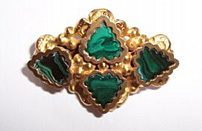
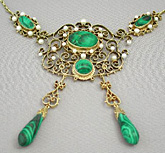

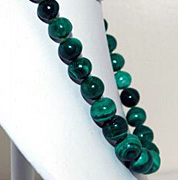
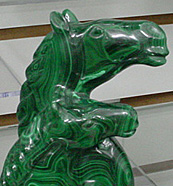
The lovely colors and patterns, easy workability, and the ready supply of fine material also endear it to today's lapidary artists for use in intarsias and inlays.
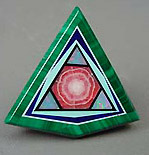

Mineral and gemstone collectors compete to acquire prime malachite specimens which show some of its rarer habits. Botryoidal masses, stalactites or slices cut from them, and specimens with splayed out clusters of needle-like (acicular) crystals showing a velvety chatoyance are highly prized.


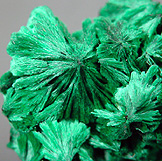
Happily, along with malachite in those secondary deposits are other copper containing minerals which sometimes end up combined in the same specimens. Along with malachite's forest green, the addition of blue-green chrysocolla, dark blue azurite, or brick red cuprite can create rocks of surpassing beauty.
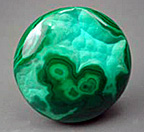
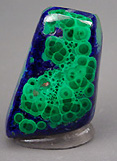
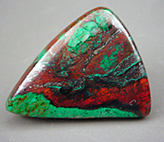
Malachite is rarely enhanced, although lower quality, less compact pieces may be stabilized with plastic resins or given a surface polish with wax. Although synthetic malachite has been manufactured for research purposes, it has not much been found in the gem marketplace to date. There would be little point, as the synthetic material would be far more costly than the natural mineral which is in abundant supply.
Malachite is plentiful in its typical forms, so even the best specimens are modestly priced. Pieces showing an unusual crystal habit, distinctive pattern, or chatoyance, will have higher values. Likewise, rocks consisting of malachite and other colorful copper minerals in lovely combinations generally command higher prices than do pure malachites. The value of carvings and ornamental objects will hinge primarily on their size, and artistry of the work.
Malachite is soft and somewhat brittle, and is sensitive to both heat and acids. It requires gentle care, so no ultrasonic or steam cleaning should be done. Use in rings, bracelets, belt buckles, or other jewelry that gets rough and/or constant wear is not advisable. On the other hand it is an appropriate and delightful gem for earrings, brooches, pendants, tie pins, and occasional wear rings or bracelets.